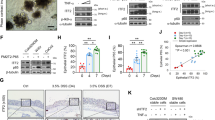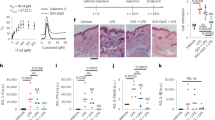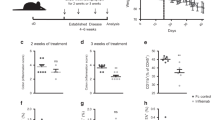Abstract
Chronic intestinal inflammation induced by 2,4,6,–trinitrobenzene sulfonic acid (TNBS) is characterized by a transmural granulomatous colitis that mimics some characteristics of human Crohn's disease. Here, we show that the transcription factor NF–κB p65 was strongly activated in TNBS–induced colitis and in colitis of interleukin–10–deficient mice. Local administration of p65 antisense phosphorothioate oligonucleotides abrogated clinical and histological signs of colitis and was more effective in treating TNBS–induced colitis than single or daily administration of glucocorticoids. The data provide direct evidence for the central importance of p65 in chronic intestinal inflammation and suggest a potential therapeutic utility of p65 antisense oligonucleotides as a novel molecular approach for the treatment of patients with Crohn's disease.
This is a preview of subscription content, access via your institution
Access options
Subscribe to this journal
Receive 12 print issues and online access
$209.00 per year
only $17.42 per issue
Buy this article
- Purchase on Springer Link
- Instant access to full article PDF
Prices may be subject to local taxes which are calculated during checkout
Similar content being viewed by others
References
Podolsky, D.K. Inflammatory bowel disease. N. Engl. J. Med. 325, 928–935 (1995).
Strober, W. & Neurath, M.F. Immunological diseases of the gastrointestinal tract. in Clinical Immunology (ed. Rich, R.R.) 1401–1428 (Mosby, St. Louis, 1995).
Strober, W. & Ehrhardt, R.O. Chronic intestinal inflammation: an unexpected outcome on cytokine or T cell receptor mutant mice. Cell 75, 203–205 (1993).
Hammer, R.E. et al. Spontaneous inflammatory disease in transgenic rats expressing HLA-B27 and human [32m: An animal model of HLAB-27-associated human disorders. Cell 63, 1099–1112 (1990).
Hermiston, M.L. & Gordon, J.I. Inflammatory bowel disease and adenomas in mice expressing a dominant negative N-cadherin. Science 270, 1203–1207 (1995).
Hollander, G.A. et al. Severe colitis in mice with aberrant thymic selection. Immunity 3, 27–38 (1995).
Sadlack, B. et al. Ulcerative colitis-like disease in mice with a disrupted interleukin-2 gene. Cell 75, 253–261 (1993).
Kiihn, R., Lohler, J., Rennick, D., Rajewsky, K. & Miiller, W. Interleukin-10-deficient mice develop chronic enterocolitis. Cell 75, 263–274 (1993).
Rudolph, U. et al. Ulcerative colitis and adenocarcinoma of the colon in Gai2-deficient mice. Nature Genet. 10, 143–146 (1995).
Mombaerts, P. et al. Spontaneous development of inflammatory bowel disease in T cell receptor mutant mice. Cell 75, 275–282 (1993).
Powrie, F. F. etal. Inhibition of Thl responses prevents inflammatory bowel disease in scid mice reconstituted with CD45RBM CD4+ T cells. Immunity 1, 553–562 (1994).
Neurath, M.F., Fuss, I., Kelsall, B.L., Stuber, E. & Strober, W. Antibodies to IL-12 abrogate established experimental colitis in mice. J. Exp. Med. 182, 1280–1289 (1995).
Stuber, E., Strober, W. & Neurath, M.F. Blocking the CD40L-CD40 interaction in vivo specifically prevents the priming of Thl-T cells through the inhibition of IL-12 secretion. J. Exp. Med. 183, 693–698 (1996).
Cross, S.L. et al. Functionally distinct NF-κB binding sites in the Ig kappa and IL-2 receptor alpha chain genes. Science 244, 466–469 (1989).
Finco, T.S. & Baldwin, A.S. Mechanistic aspects of NF-κB regulation: The emerging role of phosphorylation and proteolysis. Immunity 3, 263–272 (1995).
Lenardo, M.J. & Baltimore, D. NF-κB: A pleiotropic activator of inducible and tissue specific gene control. Cell 58, 227–237 (1989).
Baeuerle, P.A. & Henkel, T. Function and activation of NF-κB in the immune system. Annu. Rev. Immunol. 12, 141–179 (1994).
Sha, W. et al. Targeted disruption of the p50 subunit of NF-κB leads to multifo-cal defects in immune responses. Cell 80, 321–330 (1995).
Weih, F. et al. Multiorgan inflammation and hematopoietic abnormalities in mice with a targeted disruption of RelB, a member of the NF-κBJRel family. Cell 80, 331–340 (1995).
Kontgen, F. et al. Mice lacking the c-rel proto-oncogene exhibit defects in lymphocyte proliferation, humoral immunity, and interleukin-2 expression. Genes Dev. 9, 1965–1977 (1995).
Burkly, L. et al. Expression of relB is required for the development of thymic medulla and dendritic cells. Nature 373, 531–536 (1995).
Shakhov, A.N. et al. KB-type enhancers are involved in lipopolysaccharide-mediated transcriptional activation of the tumor necrosis factor a gene in primary macrophages. J. Exp. Med. 171, 35–47 (1990).
Libermann, T.A. & Baltimore, D. Activation of interleukin-6 gene expression through the NF-κB transcription factor. Mol. Cell. Biol. 10, 2327–2334 (1990).
Higgins, K.A. et al. Antisense inhibition of the p65 subunit of NF-κB blocks tu-morigenicity and causes tumor regression. Proc. Natl. Acad. Sci. USA 90, 9901–9905 (1993).
Kitajima, I. et al. Ablation of transplanted HTLV-I Tax-transformed tumors in mice by antisense inhibition of NF-κB. Science 258, 1792–1795 (1992).
Krieg, A.M. CpG motifs in bacterial DNA trigger direct B cell activation. Nature 374, 546–549 (1995).
Loke, S.L. et al. Delivery of c-myc antisense phosphorothioate oligodeoxynu-cleotides to hematapoietic cells in culture by liposome fusion: Specific reduction in c-Myc protein expression correlates with inhibition of cell growth and DNA synthesis. Curr. Top. Microbiol. Immunol. 141, 282–288 (1988).
Venturelli, D., Travali, S. & Calabretta, B. Inhibition of T-cell proliferation of a Myb antisense oligomer is accompanied by selective down-regulation of DNA polymerase alpha expression. Proc. Natl. Acad. Sci. USA 87, 5963–5967 (1990).
Voltieri, M. et al. Antisense myb inhibition of purified erythroid progenitors in development and differentiation is linked to cyclin activity and expression of DNA polymerase alpha. Blood 77, 1181–1190 (1991).
Holt, J.T. et al. Inducible production of c-fos antisense RNA inhibits 3T3 cell proliferation. Proc. Natl. Acad. Sci. USA 83, 4794–4798 (1986).
Nishikura, K. & Murray, J.M. Antisense RNA of proto-oncogene c-fos blocks renewed growth of quiescent 3T3 cells. Mol. Cell. Biol. 7, 639–648 (1987).
Wakatsuki, Y., Neurath, M.F., Max, E.E. & Strober, W. The B cell specific transcription factor BSAP regulates B cell proliferation. J. Exp. Med. 179, 1099–1108 (1994).
Gura, T. Antisense has growing pains. Science 270, 575–577 (1995).
Wagner, R.W. et al. Antisense gene inhibition by oligonucleotides containing C-5 propyne pyrimidines. Science 260, 1510–1514 (1993).
Wagner, R.W. Gene inhibition using antisense oligodeoxynucleotides. Nature 372, 333–335 (1994).
Nesterova, M. & Cho-Chung, Y.S. A single-injection protein kinase A-directed antisense treatment to inhibit tumour growth. Nature Med. 1, 528–533 (1995).
Holt, J.T. A ‘senseless’ immune response to DNA. Nature Med. 1, 407–408 (1995).
Wringhton, C.J. et al. Inhibition of endothelial cell activation by adenovirus-mediated expression of IKBCX, an inhibitor of the transcription factor NF-κB. J. Exp. Med. 183, 1013–1022 (1996).
van Dullemen, H.M. et al. Treatment of Crohn's disease with anti-tumor necrosis factor chimeric monoclonal antibody (cA2). Gastroenterology 109, 129–135 (1995).
Sartor, R.B. Role of intestinal microflora in initiation and perpetuation of inflammatory bowel disease. Can. J. Gastroenterol. 4, 271–277 (1990).
Duchmann, R., Schmitt, E., Knolle, P., Meyer zum Büelde, K.-H. & Neurath, M.F. Tolerance towards resident intestinal flora in mice is abrogated in experimental colitis and restored by treatment with interleukin-10 or antibodies to interleukin-12. Eur. J. Immunol. 26, 934–938 (1996).
Wang, P., Wu, P., Siegel, M.L., Egan, R.W. & Billah, M.M. Interleukin (IL)-10 inhibits nuclear factor B (NF kappa B) activation in human monocytes: IL-10 and IL-4 suppress cytokine synthesis by different mechanisms. J. Biol. Chem. 270, 9558–9563 (1995).
Scheinman, R.I., Cogswell, P.C., Lofquist, A.K. & Baldwin, A.S. Role of transcriptional activation of IKBOC in mediation of immunosuppression by glucocor-ticoids. Science 270, 283–286 (1995).
Auphan, N., DiDonato, J.A., Rosette, C., Helmberg, A. & Karin, M. Immunosuppression by glucocorticoids: inhibition of NF-κB activity through induction of IKBCC synthesis. Science 270, 286–290 (1995).
Neurath, M.F., Max, E.E. & Strober, W. Pax5 (BSAP) regulates the murine immunoglobulin 3'a enhancer by affecting binding of NF-aP, a protein that controls heavy chain transcription. Proc. Natl. Acad. Sci. USA 92, 5336–5340 (1995).
Demczuk, S., Harbers, M. & Vennstrom, B. Identification and analysis of all components of a gel retardation assay by combination with immunoblotting. Proc. Natl. Acad. Sci. USA 90, 2574–2578 (1993).
Bull, D.M. & Bookman, M.A. Isolation and functional characterization of human intestinal mucosal mononuclear cells. J. Clin. Invest. 59, 966–974 (1977).
Author information
Authors and Affiliations
Rights and permissions
About this article
Cite this article
Neurath, M., Pettersson, S., Meyer Zum Büschenfelde, KH. et al. Local administration of antisense phosphorothiate olignucleotides to the p65 subunit of NF–κB abrogates established experimental colitis in mice. Nat Med 2, 998–1004 (1996). https://doi.org/10.1038/nm0996-998
Received:
Accepted:
Issue Date:
DOI: https://doi.org/10.1038/nm0996-998
This article is cited by
-
Local delivery of gaseous signaling molecules for orthopedic disease therapy
Journal of Nanobiotechnology (2023)
-
Satureja khuzistanica Jamzad essential oil and pure carvacrol attenuate TBI-induced inflammation and apoptosis via NF-κB and caspase-3 regulation in the male rat brain
Scientific Reports (2023)
-
The role of diosgenin in crohn’s disease
Clinical Phytoscience (2022)
-
METTL3 overexpression aggravates LPS-induced cellular inflammation in mouse intestinal epithelial cells and DSS-induced IBD in mice
Cell Death Discovery (2022)
-
Anti-inflammatory Effects of Ivermectin in the Treatment of Acetic Acid-Induced Colitis in Rats: Involvement of GABAB Receptors
Digestive Diseases and Sciences (2022)



